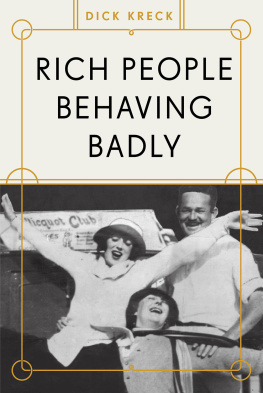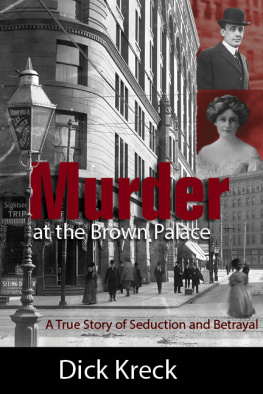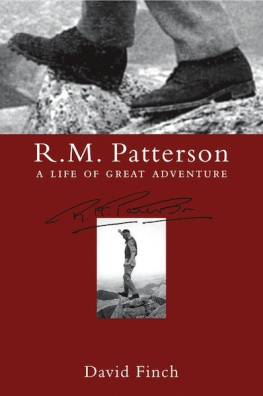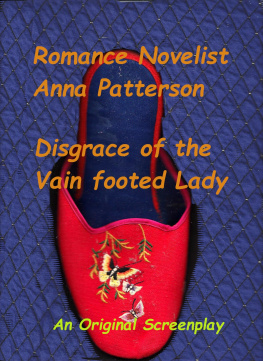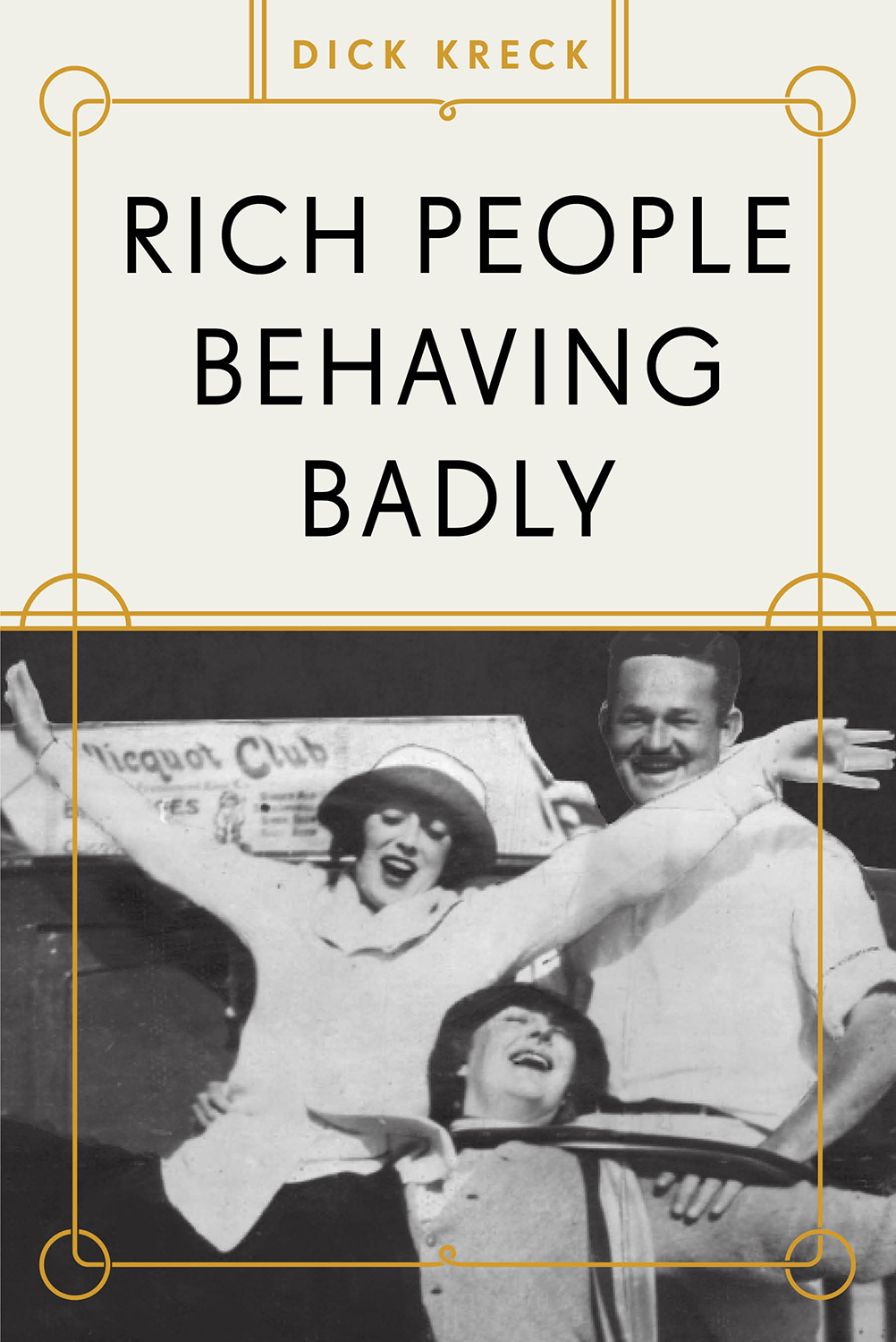Dick Kreck
Rich Pe o ple
Behaving
Badly
Authors Note
The publics interest in the naughty and sometimes murderous behavior of the rich and/or famous seems never-ending. Its the reason television reality shows and online gossip are wildly popular and why sensational trials and tribulations of stars and would-be stars capture our interest.
Historical research gives a broader perspective. The foibles of people, rich or poor, remain the same; only fashions change. Public respectability does not always translate into tidy private lives. One hundred years ago and down through the years, murders, infidelities, financial misdeeds, and just plain misbehavior have captured the medias attention. Literally, volumes have been written.
Included here are socialites such as Louise Sneed Hill, who created and ruled over Denvers Sacred 36 circle of society and kept company with a dashing polo player; Jane Tomberlin, who met and fell in love with a prince in an elevator at the Brown Palace Hotel; Irene Nolan, who cavorted late into the night with her family priest; and prominent Denver clubman Courtland Dines, wounded during a frolic with two silent-screen stars in his Hollywood apartment.
And then there are the plain wrongdoers: Frederick Bonfils, cofounder of The Denver Post , dipping his fingers in the oily scandal of the Teapot Dome mess; Fred Ward, the car dealer who peddled Hudsons he didnt own; and Pastor Charles Blair, whose financial sleight of hand brought down his religious empire.
Two of the stories in this book are not about rich people, but nevertheless screamed for telling. Pearl OLoughlin, married to a Denver cop and accused of killing her stepdaughter in 1930, deserved a closer look because it became clear to me that the evidence against her was questionable at best. She served twenty years of a life sentence and maintained her innocence until she was paroled in 1952. She may not have done it.
The story of early-day Denver prostitute Mattie Young is a cautionary episode that demonstrates the chaotic and often tragic life the brides of the multitudes led. The romanticized version in movies and on television of merry young women in flouncy dresses amid sumptuous surroundings doesnt begin to reflect the grinding day-to-day lives of desperation prostitutes led. Drugs, physical abuse, and suicides snuffed too many too young.
Portions of The Butterfly, the tale of Isabel Springer, wife of a prominent Denver businessman; her two lovers; and the tragic shooting in 1911 appear in a longer version in my book Murder at the Brown Palace . It remains one of the citys most scandalous episodes.
And so it goes. They made us look.
Acknowledgments
No history book gets written without support. Some of the people I need to thank:
First, my sharp-eyed editor, Alison Auch; the always-helpful staff at the Genealogy and Western History Department, Denver Public Library; Shaun Boyd, Local History Collection, Douglas County Library, Castle Rock, Colorado; Castle Rock Historical Society and Museum, Castle Rock, Colorado; Stacey Cline, Museum of Colorado Prisons, Caon City, Colorado; Colorado State Archives; Coi Drummond-Gehrig, image sales/research, Genealogy and Western History Department, Denver Public Library; Vickie Makings, The Denver Post library; Faith Marcovecchio, my friend and sometime editor; Dianne Millican Miller; crack genealogist Loujean Rehn; Richard Schilling; Stephen H. Hart and Research Center at History Colorado; Lisa Studts, curator, Royal Gorge Regional Museum and History Center, Caon City, Colorado; Ray Thal, Riverside Cemetery, Denver. And especially the scores of anonymous journalists who so vividly described too-human peccadilloes for our prying eyes.
ALSO BY DICK KRECK
Colorados Scenic Railroads
Denver in Flames
Murder at the Brown Palace
Anton Woode: The Boy Murderer
Smaldone: The Untold Story of an American Crime Family
Hell on Wheels: Wicked Towns Along the Union Pacific Railroad
Cover photo: Socially prominent Denver clubman Courtland Dines cavorts with silent-screen stars Mabel Normand, center, and Edna Purviance on a jolly seagoing outing to Catalina Island off the coast of California. Courtesy of The Denver Post.
Text Dick Kreck 2016
All rights reserved. No part of this book may be reproduced or transmitted in any form or by any means, electronic or mechanical, including photocopying, recording, or by an information storage and retrieval systemexcept by a reviewer who may quote brief passages in a reviewwithout permission in writing from the publisher.
Library of Congress Cataloging-in-Publication Data
Names: Kreck, Dick, author.
Title: Rich people behaving badly / by Richard Kreck.
Description: Golden, CO : Fulcrum Publishing, [2016]
Identifiers: LCCN 2016006643 | ISBN 9781936218233 (paperback)
Subjects: LCSH: Scandals--Colorado--Case studies. | Crime--Colorado--Case studies. | Rich people--Colorado--Case studies. | Colorado--Social life and customs. | Colorado--History. | BISAC: HISTORY / United States / State & Local / West (AK, CA, CO, HI, ID, MT, NV, UT, WY). | TRUE CRIME / General.
Classification: LCC F776 .K74 2016 | DDC 978.8--dc23
LC record available at http://lccn.loc.gov/2016006643
Printed in the United States of America
0 9 8 7 6 5 4 3 2 1
Fulcrum Publishing
4690 Table Mountain Dr., Ste. 100
Golden, CO 80403
800-992-2908 303-277-1623
www.fulcrumbooks.com
Chapter 1
The Great Scandal
William Newton Byers
A pistol-waving woman scorned is not to be trifled with.
On April 5, 1876, less than a week after a spring snowstorm buried Denver under a foot of snow, things heated up for William Newton Byers, a pioneer pillar of the community and owner/publisher of the Rocky Mountain News .
Robert Perkin in his book The First Hundred Years , the entertaining and informative history of the News , reasoned, The scandal had nothing but the highest-quality ingredients. A pioneer and civic dignitary, strictly top of the heap, respected, envied by many, probably maliciously and privately disliked by some for his prominence and many honors. A beautiful young woman, a divorcee (practically scandalous in itself), and the rumors were that she was pretty fast.
Byers, who had hopes of becoming the soon-to-be states first governor, found himself in the arms of a scandal that involved an ardent divorce bent on his destruction, a series of passionate letters, an outraged wife, and a newspaper war.
Byers was a native of Ohio, and he spent the early 1850s as a surveyor in Iowa, on the West Coast, and in Omaha, Nebraska. He had a sudden revelation that it was time to move on to the wide-open spaces of Colorado and start a newspapera trade he knew nothing about. But he knew that a newspaper could be a driving force in the success of any new town.
He arrived in Denver at age twenty-eight on April 17, 1859, when the settlement at the confluence of the South Platte River and Cherry Creek was barely a year old. It was little more than a collection of shacks and teepees, with a populationliberally countedof four hundred. Those who hit town were usually passing through on their way to the gold diggings in the Rockies. Within a year, more substantial structures were rising, and ten years after that, Denver became a rail hub and the major city in the Rocky Mountain region.
Byers had hauled an antiquated press and a few trays of type overland by wagon and he published the first issue of the News on April 23. It was his wife, Elizabethwhom he married in Muscatine, Iowa, in 1854, and brought with him to Denver in 59who suggested the papers masthead. The paper immediately became a megaphone through which Byers, who saw a bright future where dirt and sagebrush reigned, bellowed the hopes and dreams of the fledgling village.

